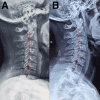Cervicogenic Dizziness After Self-Manipulation of the Cervical Spine
- PMID: 37020712
- PMCID: PMC10068692
- DOI: 10.7759/cureus.37051
Cervicogenic Dizziness After Self-Manipulation of the Cervical Spine
Abstract
Patients with pre-existing cervical pathologies who experience dizziness and related neck pain are referred to as having cervicogenic dizziness. We describe a case of a 49-year-old female who presented with acute onset of vertigo and imbalance following self-manipulation of the cervical spine. Examination revealed a restricted cervical range of motion, muscle hypertonicity, and positive neurological signs. Radiographs demonstrated loss of normal cervical lordosis. The patient was diagnosed with cervicogenic dizziness and prescribed chiropractic treatments that included spinal manipulation, soft tissue release, and rehabilitative exercises. After four weeks of care, her symptoms had improved. At the six-month follow-up, the patient remained asymptomatic with a full cervical range of motion. This case highlights the risks associated with neck manipulation and the effectiveness of chiropractic treatment for cervicogenic dizziness. Patients should be counseled to seek evaluation and treatment from appropriate medical professionals for neck issues or dizziness/imbalance.
Keywords: cervicogenic dizziness; chiropractic therapy; chiropractor; self spinal manipulation; spinal manipulation.
Copyright © 2023, Chu et al.
Conflict of interest statement
The authors have declared that no competing interests exist.
Figures


Similar articles
-
The effect of normalizing the sagittal cervical configuration on dizziness, neck pain, and cervicocephalic kinesthetic sensibility: a 1-year randomized controlled study.Eur J Phys Rehabil Med. 2017 Feb;53(1):57-71. doi: 10.23736/S1973-9087.16.04179-4. Epub 2016 Aug 30. Eur J Phys Rehabil Med. 2017. PMID: 27575013 Clinical Trial.
-
Short-term effects of an upper cervical spine traction-manipulation program in patients with cervicogenic dizziness: A case series study.J Back Musculoskelet Rehabil. 2020;33(6):961-967. doi: 10.3233/BMR-181479. J Back Musculoskelet Rehabil. 2020. PMID: 32144976
-
Short-term effects of the traction-manipulation protocol in dizziness intensity and disability in cervicogenic dizziness: a randomized controlled trial.Disabil Rehabil. 2022 Jul;44(14):3601-3609. doi: 10.1080/09638288.2021.1872719. Epub 2021 Jan 20. Disabil Rehabil. 2022. PMID: 33470861
-
The use of dry needling as a diagnostic tool and clinical treatment for cervicogenic dizziness: a narrative review & case series.J Bodyw Mov Ther. 2018 Oct;22(4):947-955. doi: 10.1016/j.jbmt.2018.02.015. Epub 2018 Feb 17. J Bodyw Mov Ther. 2018. PMID: 30368340 Review.
-
Cervicogenic dizziness: a review of diagnosis and treatment.J Orthop Sports Phys Ther. 2000 Dec;30(12):755-66. doi: 10.2519/jospt.2000.30.12.755. J Orthop Sports Phys Ther. 2000. PMID: 11153554 Review.
Cited by
-
Homocysteine, HHcy, H-type hypertension and dizziness: an NHANES analysis.Front Neurol. 2025 Jul 14;16:1550568. doi: 10.3389/fneur.2025.1550568. eCollection 2025. Front Neurol. 2025. PMID: 40726628 Free PMC article.
-
The Inclusion of Chiropractic Care in the Healthy China Initiative 2030.Cureus. 2023 Aug 7;15(8):e43068. doi: 10.7759/cureus.43068. eCollection 2023 Aug. Cureus. 2023. PMID: 37680438 Free PMC article.
-
Safety and efficacy of traditional Chinese manual therapy for cervicogenic dizziness: study protocol for a randomized, controlled, multicenter trial.Contemp Clin Trials Commun. 2024 Aug 18;41:101349. doi: 10.1016/j.conctc.2024.101349. eCollection 2024 Oct. Contemp Clin Trials Commun. 2024. PMID: 39262903 Free PMC article.
-
Dual analysis of postural control in middle-aged and elderly patients with cervicogenic dizziness: Dynamic and static balance perspectives.Front Bioeng Biotechnol. 2025 Jul 22;13:1622648. doi: 10.3389/fbioe.2025.1622648. eCollection 2025. Front Bioeng Biotechnol. 2025. PMID: 40766971 Free PMC article.
References
-
- Cervicogenic dizziness: a review of diagnosis and treatment. Wrisley DM, Sparto PJ, Whitney SL, Furman JM. J Orthop Sports Phys Ther. 2000;30:755–766. - PubMed
Publication types
LinkOut - more resources
Full Text Sources
